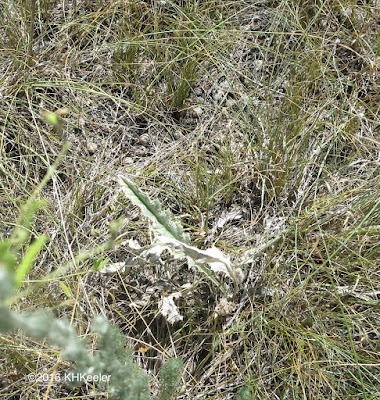Wavy leaf thistle,
Cirsium undulatum, is a native thistle of the plains and the west of North America (sunflower family, Asteraceae). Thistles are a weird group: some are rare and endangered, some are extremely abundant noxious weeds. Wavy leaf isn't currently protected, but it is closer to being rare than noxious.
 |
| Rosette of wavyleaf thistle |
Wavyleaf is a perennial thistle with big purple flower heads. It grows for several years before sending up the flower. Generally the whole plant dies after the plant flowers because it put all the energy it had into seeds. Saving enough energy to flower may take ten years. The west has a dry, unpredictable climate so the plant may endure many poor years. Many plants die before flowering. In good years there will be widespread flowering as numerous plants get big enough to flower.
 |
| Wavyleaf thistle with developing fruits. |
But the story isn't that simple. Underground, wavy leaf often sends out a rhizome (below-ground shoot) or two, so the particular plant (clump) has died, but not the genetic individual. (Being sure this is true is difficult. Digging up thistle rhizomes is not great fun and I know of only a single study looking at DNA in wavy leaf, However what data there is, is consistent with that interpretation.)
 |
| wilting rosette |
Lots of plant biology makes sense in the context of the environment. Wavy leaf thistle is found on the western plains where the rainfall is slight and irregular. Seeds might germinate in a period with ample sustained moisture, but many times the moisture runs out and they die. Once a plant's roots reach well down into the ground, the plant has a much better chance of surviving. Consequently, established wavy leaf thistle plants grow long lateral rhizomes that send up a shoot at the far end and drop down their own roots. Whether the plants stay attached a long time sharing water and nutrients or become independent quickly (the studies have not been done for wavy leaf thistle), the initial support for clonal rosettes gives them a much better chance of survival than little seeds have.
Seeds are essential for genetic variation and to colonize areas farther away, but clones keep population stable.
 |
They looked like four different small plants,
but underground they were connected. |
For wavy leaf thistle, determining which clones are from which plant is difficult, because they often go three feet down in the soil and then laterally for another three feet. The picture above shows four little rozettes that are part of the same plant. Had the root divided below where I broke it they would have looked like four independent little plants. Deep roots are important for survival in dry climates but make it hard for botanists to know what is going on.
 |
| One wavy leaf thistle plant or two in the shade of this tree? |
Unlike weedy thistles from Europe that left the insects that eat them behind in Europe, wavy leaf thistle has a wide range of native insect enemies. Often, if you open a seed head, all that you find inside are the insects that ate the seeds, no seeds. Those native enemies mean you are more likely to find an isolated plant, not a dense patch of wavy leaf thistles.
 |
| Wavy leaf thistle hanging off a slope. |
It is not available commercially, which is too bad because not only is the purple flower head very pretty--
more pictures--it attracts many bees and butterflies.
Comments and corrections welcome.
Kathy Keeler, A Wandering Botanist







I'm sure I found a whole batch of wavyleaf thistles I'm not a hundred percent sure but none of them have bloomed and there are quite a few insects
ReplyDeleteNot only is the flower beautiful and attractive to insects, it is one of the most heavenly fragrant flowers I know of, though in my personal experience the fragrance is variable.
ReplyDeleteI so wish I could find some of these. I love thistles but all I can find so far are the very tall non-natives that Oklahoma lists as noxious weeds and requires a landowner to control. Still going to keep looking though!
ReplyDelete